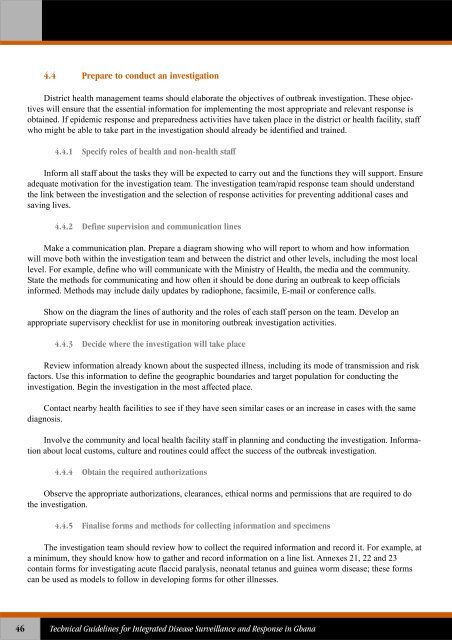Technical Guidelines for Integrated Disease Surveillance ... - PHRplus
Technical Guidelines for Integrated Disease Surveillance ... - PHRplus
Technical Guidelines for Integrated Disease Surveillance ... - PHRplus
Create successful ePaper yourself
Turn your PDF publications into a flip-book with our unique Google optimized e-Paper software.
4.4 Prepare to conduct an investigationDistrict health management teams should elaborate the objectives of outbreak investigation. These objectiveswill ensure that the essential in<strong>for</strong>mation <strong>for</strong> implementing the most appropriate and relevant response isobtained. If epidemic response and preparedness activities have taken place in the district or health facility, staffwho might be able to take part in the investigation should already be identified and trained.4.4.1 Specify roles of health and non-health staffIn<strong>for</strong>m all staff about the tasks they will be expected to carry out and the functions they will support. Ensureadequate motivation <strong>for</strong> the investigation team. The investigation team/rapid response team should understandthe link between the investigation and the selection of response activities <strong>for</strong> preventing additional cases andsaving lives.4.4.2 Define supervision and communication linesMake a communication plan. Prepare a diagram showing who will report to whom and how in<strong>for</strong>mationwill move both within the investigation team and between the district and other levels, including the most locallevel. For example, define who will communicate with the Ministry of Health, the media and the community.State the methods <strong>for</strong> communicating and how often it should be done during an outbreak to keep officialsin<strong>for</strong>med. Methods may include daily updates by radiophone, facsimile, E-mail or conference calls.Show on the diagram the lines of authority and the roles of each staff person on the team. Develop anappropriate supervisory checklist <strong>for</strong> use in monitoring outbreak investigation activities.4.4.3 Decide where the investigation will take placeReview in<strong>for</strong>mation already known about the suspected illness, including its mode of transmission and riskfactors. Use this in<strong>for</strong>mation to define the geographic boundaries and target population <strong>for</strong> conducting theinvestigation. Begin the investigation in the most affected place.Contact nearby health facilities to see if they have seen similar cases or an increase in cases with the samediagnosis.Involve the community and local health facility staff in planning and conducting the investigation. In<strong>for</strong>mationabout local customs, culture and routines could affect the success of the outbreak investigation.4.4.4 Obtain the required authorizationsObserve the appropriate authorizations, clearances, ethical norms and permissions that are required to dothe investigation.4.4.5 Finalise <strong>for</strong>ms and methods <strong>for</strong> collecting in<strong>for</strong>mation and specimensThe investigation team should review how to collect the required in<strong>for</strong>mation and record it. For example, ata minimum, they should know how to gather and record in<strong>for</strong>mation on a line list. Annexes 21, 22 and 23contain <strong>for</strong>ms <strong>for</strong> investigating acute flaccid paralysis, neonatal tetanus and guinea worm disease; these <strong>for</strong>mscan be used as models to follow in developing <strong>for</strong>ms <strong>for</strong> other illnesses.46<strong>Technical</strong> <strong>Guidelines</strong> <strong>for</strong> <strong>Integrated</strong> <strong>Disease</strong> <strong>Surveillance</strong> and Response in Ghana















